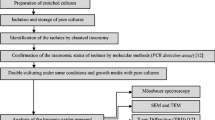Abstract
Bacterial biomass collected from sheath-forming bacteria of the genera Sphaerotilus and Leptothrix was collected from a high-mountain natural stream water source. The elemental constitution and oxide phases of the products after selective cultivation of the bacteria on two different elective media using neutron activation analysis (NAA), electron microscopy (SEM, TEM), and X-ray diffraction (XRD) were studied. A high enrichment level of iron was revealed by the NAA technique in cultivated isolates as compared to the reference sample from nature. Three types of iron oxide compounds were established after cultivation in Adler’s medium: lepidocrocite (γ-FeOOH), magnetite (Fe3O4), and goethite (α-FeOOH). The cultivation in the Isolation medium yielded a single phase, that of goethite, excluding one sample with a distinguishable amount of lepidocrocite. XRD and EM investigations show that the biogenic oxides are nanosized. Our study exemplifies the possibilities of the biotechnology approach for obtaining, under artificial conditions, large quantities of iron-containing by-products that could be of further used in appropriate nano- and biotechnologies.





Similar content being viewed by others
References
Emerson, D., Fleming, E.J., McBeth, J.M.: Iron-oxidizing bacteria: an environmental and genomic perspective. Annu. Rev. Microbiol. 64, 561–583 (2010)
Schüler, D., Frankel, R.B.: Bacterial magnetosomes: microbiology, biomineralization and biotechnological applications. Appl. Microbiol. Biotechnol. 52, 464–473 (1999)
Cornell, R.M., Schwertmann, U.: Iron Oxides, 2nd edn, p. 484. John Wiley & Sons, New York (2003)
Sawayama, M.: Isolation of a Leptothrix strain, OUMS1, from ocherous deposits in groundwater. Curr. Microbiol. 63, 173–180 (2011)
Budapest Neutron Centre, http://www.bnc.hu
Bergey’s Manual of Determinative Bacteriology, 8th edition, Edited by R. E. Buchanan and N. E. Gibbons, p.1246. Williams & Wilkins Company, Baltimore (1974)
Handbook of Nuclear Chemistry, Vértes, A., Nagy, S., Klencsár, Z., Lovas, R.G., Rösch, F. (eds.) 2nd ed., in vol. 6, p. 3049. Springer Science & Business Media, ISBN 978-1-4419-0719-6. (2011)
Ellis, D.: Microbiology of the Iron-Depositing Bacteria. Wexford College Press, Palm Springs, CA (2003)
Eaton, A.D., Clesceri, L.S., Rice, W., Greenberg, A.W.: Standard Methods for the Examination of Water and Wastewater, 21st edn. APHA, Washington, D.C. (2005)
Simonits, A., De Corte, F., Hoste, J.: Zirconium as a multi-isotopic flux ratio monitor and a single comparator in reactor-neutron activation analysis. J. Radioanal. Nucl. Chem. 31, 467–486 (1976)
Acknowledgments
This work was supported by the Bulgarian National Science Fund under project DID02/38/2009. The partial financial support through the HAS (RISSPO) – BAS (INRNE) bilateral agreement for collaboration 2013/2015 and the EU-FP7 NMI3 project is gratefully acknowledged.
Author information
Authors and Affiliations
Corresponding author
Rights and permissions
About this article
Cite this article
Angelova, R., Groudeva, V., Slavov, L. et al. Investigation of iron-containing products from natural and laboratory cultivated Sphaerotilus-Leptothrix bacteria. J Biol Phys 41, 367–375 (2015). https://doi.org/10.1007/s10867-015-9384-1
Received:
Accepted:
Published:
Issue Date:
DOI: https://doi.org/10.1007/s10867-015-9384-1




